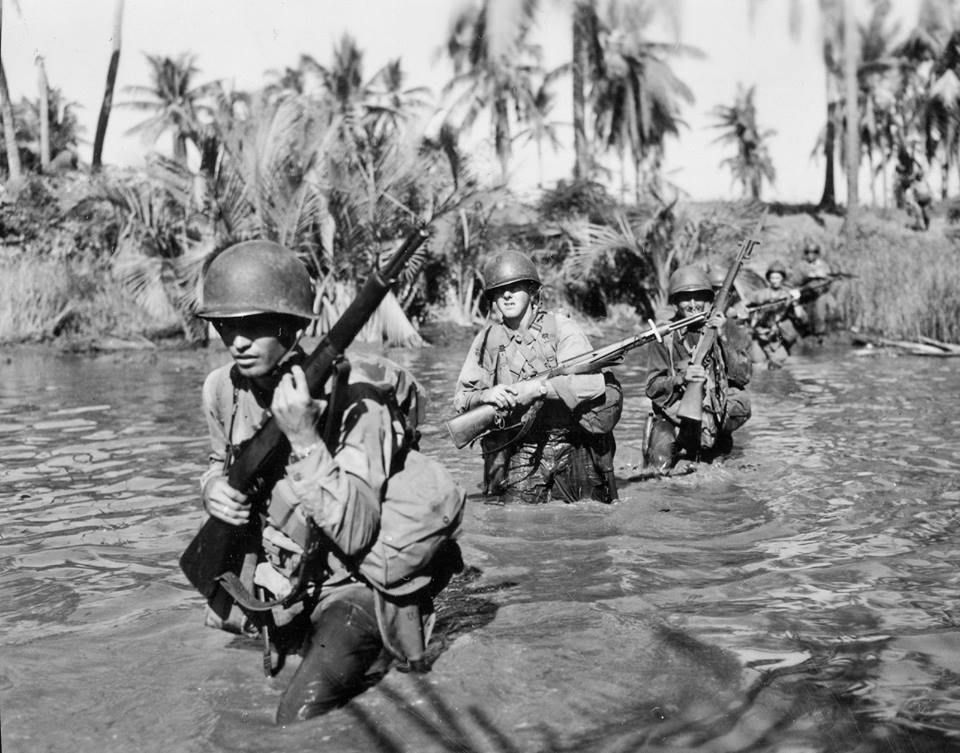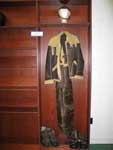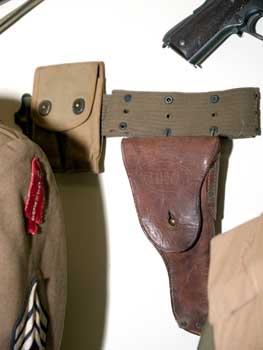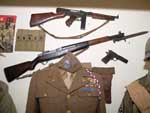
Soldiers with the 43rd Infantry are shown in this photo from the Pacific Theater during World War II. Photo courtesy of the 43rd Infantry Division on Facebook.
World War II was officially fought between 1939 and 1945. Germany's re-emergence as a world power in the late 30's was one of many individual events leading up to it. It is generally accepted that the Second World War was initiated when Germany invaded Poland. From this point on Germany's aggression eventually involved all of Europe.
At the same time, during the 30's and 40's the Japanese had invaded China and Indochina. This aggression by the Japanese, and ultimately a pact with the German government, was to cause a total global war to ensue.
The United States became involved in the War when the Japanese bombed our naval base at Pearl Harbor, Hawaii on Dec.7, 1941. Following the Japanese bombing of Pearl Harbor the United States declared war on Japan. Three days later, after Germany and Italy declared war on the U.S., cementing American engagement in the Second World War.
On May 8, 1945, Germany surrendered to the Allied forces. The destruction of Hiroshima and Nagasaki by atomic bombs brought the war in the Pacific to an abrupt end, with Japan surrendering on Aug. 14, 1945.
While thousands of Vermonters served on every front throughout World War II, the 2nd Battalion, 172nd Infantry was the only unit to deploy.
In September 1942, they departed for the South Pacific as part of the 43rd Infantry Division. There, they participated in the New Georgia Invasion with an assault on Rendova Island and the taking of Munda airfield on Aug. 5, 1943. On New Georgia, Vermont native Leonard Wing was promoted to Major General and assumed command of the 43rd. After resetting in New Zealand, the Division turned back the Japanese's attempt to break through the Wewak trap at the Drinimuor River in New Guinea. On January 9, 1945 MG Wing led the Division on the invasion of Luzon.
It completed an assault landing at San Fabian, Lingayen Gulf, with the mission to secure the Army's left flank and bottle up the Japanese at Baguio. Throughout the initial 30 days of fighting on Luzon, the Division held the Japanese in the mountains, while other Divisions smashed through to Manilla. By late January, the 43rd had overrun 125 artillery positions and destroyed the Japanese defenses around Lingayen. By Feb. 13, 1945, Rosario, Sison, and Pozzorubio were in American hands, and the 43rd had killed as many Japanese soldiers as all the other divisions combined. The Division continued to press throughout the spring, culminating with the seizure of the Ipo Dam in May 1945. The 2-172nd spearheaded the assault that would later earn the Division the nickname, "Winged Victory" in honor of Maj. Gen. Leonard Wing, who is the only National Guard officer to retain command of an active combat division as a Guardsman during World War II. For their efforts, the unit received the Arrowhead device on the Meritorious Unit Citation, denoting participation in an amphibious assault landing.
The 43rd fought in the Philippines until the end of the war, returning home in October 1945.
Wing graduated from Rutland High School in 1910 and then attended Norwich University. In 1919 he joined the Vermont National Guard's 172nd Infantry Regiment as a Second Lieutenant and served as Rutland City Attorney until 1921. From 1921-1925 Wing served as Rutland's City Judge. He rose through the ranks and in 1933 received promotion to Colonel as the 172nd's commander. He was promoted to Brigadier General in 1937 as commander of the 86th Infantry Brigade, 43rd Infantry Division. In 1939 Wing was elected to Norwich University's Board of Trustees and was named Executive Assistant to Governor Stanley Wilson. In 1942 he was named commander of the division's 68th Field Artillery Brigade, and later that year he was appointed as the 43rd Assistant Division Commander. He became the Division's commander in 1943 as a Major General. He tragically died in December 1945 from a heart attack, just two months after returning home from the war.
Below are links to Vermont WWII casualties, as listed in the National archives for:





